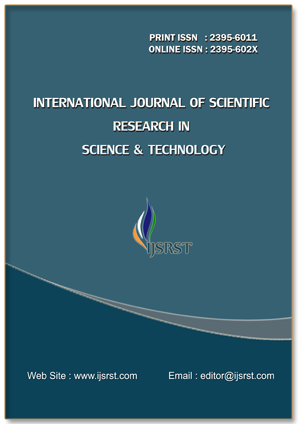In-Silico Riboswitch Based Drug Design for SARS 1
DOI:
https://doi.org/10.32628/IJSRST24114102Keywords:
Riboswitch, Virtual Screening, AutoDock, SARS Virus, InhibitorAbstract
Protein from the coronavirus causing severe acute respiratory syndrome (SARS-CoV) is responsible for binding to and identifying amino acid residues that are important for the synthesis of S1 with ACE2. It aids in the creation of antiviral inhibitors and experimental research. Anatomical models of the SARS-CoV S1 protein in fuse with human ACE2 were created in this study. One riboswitch depict for one strain of SARS Virus and five inhibitors have been classified for this riboswitch by virtual screening. These inhibitors seen to be free from the side effects of anti-viral agents.
📊 Article Downloads
References
D. T. Houglum, “Myth-busters: Traditional and emergent leadership,” Emerg. Complex. Organ., 2012.
D. Pittet, “Hand hygiene: Improved standards and practice for hospital care,” Current Opinion in Infectious Diseases. 2003, doi: 10.1097/00001432-200308000-00004. DOI: https://doi.org/10.1097/00001432-200308000-00004
J. T. F. Lau, H. Tsui, M. Lau, and X. Yang, “SARS Transmission, Risk Factors, and Prevention in Hong Kong,” Emerg. Infect. Dis., 2004, doi: 10.3201/eid1004.030628. DOI: https://doi.org/10.3201/eid1004.030628
M. Chan-Yeung and R. H. Xu, “SARS: Epidemiology,” Respirology. 2003, doi: 10.1046/j.1440-1843.2003.00518.x. DOI: https://doi.org/10.1046/j.1440-1843.2003.00518.x
E. De Wit, N. Van Doremalen, D. Falzarano, and V. J. Munster, “SARS and MERS: Recent insights into emerging coronaviruses,” Nature Reviews Microbiology. 2016, doi: 10.1038/nrmicro.2016.81. DOI: https://doi.org/10.1038/nrmicro.2016.81
L. B. Ware, “Severe acute respiratory syndrome,” in Acute Respiratory Distress Syndrome, 2003.
D. Wu, T. Wu, Q. Liu, and Z. Yang, “The SARS-CoV-2 outbreak: What we know,” International Journal of Infectious Diseases. 2020, doi: 10.1016/j.ijid.2020.03.004. DOI: https://doi.org/10.1016/j.ijid.2020.03.004
P. V‟kovski, A. Kratzel, S. Steiner, H. Stalder, and V. Thiel, “Coronavirus biology and replication: implications for SARS-CoV-2,” Nature Reviews Microbiology. 2020, doi: 10.1038/s41579-020-00468-6. DOI: https://doi.org/10.1038/s41579-020-00468-6
M. J. Loeffelholz and Y. W. Tang, “Laboratory diagnosis of emerging human coronavirus infections–the state of the art,” Emerging Microbes and Infections. 2020, doi: 10.1080/22221751.2020.1745095. DOI: https://doi.org/10.1080/22221751.2020.1745095
J. C. Lagier et al., “Testing the repatriated for SARS-Cov2: Should laboratorybased quarantine replace traditional quarantine?,” Travel Med. Infect. Dis., 2020, doi: 10.1016/j.tmaid.2020.101624. DOI: https://doi.org/10.1016/j.tmaid.2020.101624
C. Abreu-Goodger and E. Merino, “RibEx: A web server for locating riboswitches and other conserved bacterial regulatory elements,” Nucleic Acids Res., 2005. DOI: https://doi.org/10.1093/nar/gki445
P. Bengert and T. Dandekar, “Riboswitch finder - A tool for identification of riboswitch RNAs,” Nucleic Acids Res., 2004. DOI: https://doi.org/10.1093/nar/gkh352
J. T. Havill, C. Bhatiya, S. M. Johnson, J. D. Sheets, and J. S. Thompson, “A new approach for detecting riboswitches in DNA sequences,” Bioinformatics, 2014. DOI: https://doi.org/10.1093/bioinformatics/btu479
A. Górska, A. Markowska-Zagrajek, M. Równicki, and J. Trylska, “Scanning of 16S Ribosomal RNA for Peptide Nucleic Acid Targets,” J. Phys. Chem. B, 2016. DOI: https://doi.org/10.1021/acs.jpcb.6b02081
S. Sharma, F. Ding, and N. V. Dokholyan, “IFoldRNA: Three-dimensional RNA structure prediction and folding,” Bioinformatics, 2008. DOI: https://doi.org/10.1093/bioinformatics/btn328
M. Antczak et al., “New functionality of RNAComposer: An application to shape the axis of miR160 precursor structure,” Acta Biochim. Pol., 2016. DOI: https://doi.org/10.18388/abp.2016_1329
M. Popenda et al., “Automated 3D structure composition for large RNAs,” Nucleic Acids Res., 2012. DOI: https://doi.org/10.1093/nar/gks339
G. M. Morris et al., “Software news and updates AutoDock4 and AutoDockTools4: Automated docking with selective receptor flexibility,” J. Comput. Chem., 2009. DOI: https://doi.org/10.1002/jcc.21256
T. Sterling and J. J. Irwin, “ZINC 15 - Ligand Discovery for Everyone,” J. Chem. Inf. Model., 2015. DOI: https://doi.org/10.1021/acs.jcim.5b00559
A. Daina, O. Michielin, and V. Zoete, “SwissADME: A free web tool to evaluate pharmacokinetics, drug-likeness and medicinal chemistry friendliness of small molecules,” Sci. Rep., 2017. DOI: https://doi.org/10.1038/srep42717
D. Schneidman-Duhovny, O. Dror, Y. Inbar, R. Nussinov, and H. J. Wolfson, “PharmaGist: a webserver for ligand-based pharmacophore detection.,” Nucleic Acids Res., 2008. DOI: https://doi.org/10.1093/nar/gkn187
P. Imming, C. Sinning, and A. Meyer, “Drugs, their targets and the nature and number of drug targets,” Nat. Rev. Drug Discov., 2006. DOI: https://doi.org/10.1038/nrd2132
P. P. Kore, M. M. Mutha, R. V. Antre, R. J. Oswal, and S. S. Kshirsagar, “Computer-Aided Drug Design: An Innovative Tool for Modeling,” Open J. Med. Chem., 2012. DOI: https://doi.org/10.4236/ojmc.2012.24017
N. J. Baird, N. Kulshina, and A. R. Ferré-D‟Amaré, “Riboswitch function: Flipping the switch or tuning the dimmer?,” RNA Biology. 2010. DOI: https://doi.org/10.4161/rna.7.3.11932
B. Iorga, D. Herlem, E. Barré, and C. Guillou, “Acetylcholine nicotinic receptors: Finding the putative binding site of allosteric modulators using the „blind docking‟approach,” J. Mol. Model., 2006. DOI: https://doi.org/10.1007/s00894-005-0057-z
M. Famulok, J. S. Hartig, and G. Mayer, “Functional aptamers and aptazymes in biotechnology, diagnostics, and therapy,” Chemical Reviews. 2007. DOI: https://doi.org/10.1002/chin.200751263
Z. Bikádi, E. Hazai, F. Zsila, and S. F. Lockwood, “Molecular modeling of noncovalent binding of homochiral (3S,3′S)-astaxanthin to matrix metalloproteinase13 (MMP-13),” Bioorganic Med. Chem., 2006. DOI: https://doi.org/10.1016/j.bmc.2006.04.047
C. Hetényi and D. van der Spoel, “Efficient docking of peptides to proteins without prior knowledge of the binding site,” Protein Sci., 2009.
Downloads
Published
Issue
Section
License
Copyright (c) 2024 International Journal of Scientific Research in Science and Technology

This work is licensed under a Creative Commons Attribution 4.0 International License.
https://creativecommons.org/licenses/by/4.0




